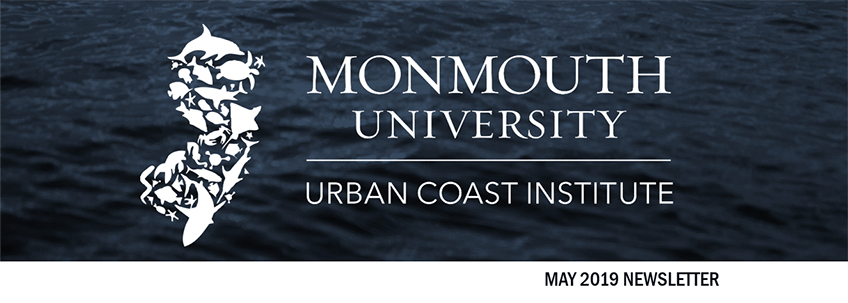
Watch Presentations from Climate Change, Coasts & Communities Symposium
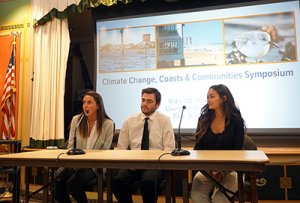 Videos, slides and other materials from the Climate Change, Coasts & Communities Symposium are now available at www.monmouth.edu/climate-coasts-communities. The event, held at Monmouth University on April 17-18, gathered leading experts from around the world in the areas of climate change adaptation law and science.
Videos, slides and other materials from the Climate Change, Coasts & Communities Symposium are now available at www.monmouth.edu/climate-coasts-communities. The event, held at Monmouth University on April 17-18, gathered leading experts from around the world in the areas of climate change adaptation law and science.
Keynote speakers included Global Ocean Forum President Biliana Cicin-Sain, University of Tasmania (Australia) Faculty of Law Professor Jan McDonald and University of Utah S.J. Quinney College of Law Professor Robin Craig. The symposium kicked off with Monmouth University students presenting their research on coastal climate adaptation issues and also included panels on:
- The legal considerations of climate change and voiceless communities, including future generations, wildlife and natural resources
- Lessons to New Jersey from around the nation and the world on adapting to seal level rise, coastal storms and flooding
- Scientific strategies to combat climate change-induced factors that are harming marine and coastal ecosystems
The event was hosted by the UCI and Monmouth University’s Wayne D. McMurray School of Humanities and Social Sciences, School of Science, Office of the Provost, Global Education Office, Department of Political Science and Sociology, and Youth Activists Group.
Additional Links
- NJTV News segment covering the symposium
- Photo album
- Symposium brochure (PDF)
World Oceans Day/Monmouth Reunion Weekend Events: Ocean Plastics Panel 6/8, Family Beach Day 6/9
Celebrate #WorldOceansDay and Monmouth University’s Reunion Weekend at these UCI-hosted events. Open to the public – spread the word!
Panel Discussion – Together We Can: A Plastic-Free Ocean
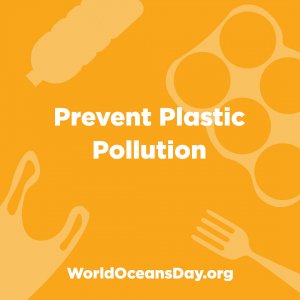 Saturday, June 8 | 2:30-3:30 p.m.
Saturday, June 8 | 2:30-3:30 p.m.
Magill Commons Club Dining Room
The UCI welcomes two Monmouth University alumni and environmental leaders back to campus for a World Oceans Day conversation on plastic pollution and steps you can take to help the problem: Coalition for the Delaware River Watershed Director Sandra Meola ’12 ’15M and Clean Ocean Action D.W. Bennett Fellow for Coastal Advocacy Zack Karvelas ’17. Moderated by UCI Director Tony MacDonald.
Refreshments will be served. Guests are encouraged to stay on campus for great fun with cocktails, food, music and friends at the Great Hall Rooftop Celebration. Please note that the Rooftop Celebration is a ticketed, sellout event ― register today!
Family Beach Day
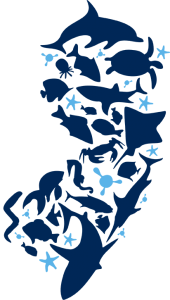 Sunday, June 9 | 10:30 a.m.
Sunday, June 9 | 10:30 a.m.
West End
Check-in at the University Bluffs (aka “The Diplomats”) to receive a wristband for discounts at businesses in West End. Enjoy fun exhibits/activities provided by the Urban Coast Institute, including a Shell & Marine Life ID table with Dr. Jason Adolf, a Science of Sand station with Dr. Tom Herrington, a live underwater drone feed from the R/V Heidi Lynn Sculthorpe and more!
Registration and More Info
For planning purposes, please register online for the panel and beach day. In lieu of a registration fee, please consider making a donation to the Urban Coast Institute Scholarship Fund.
Reunion Weekend will run from June 7-9. For a full schedule of activities and other details, visit www.monmouth.edu/alumni/reunion-weekend/.
UCI Scholars Program to Support Six Summer Research Projects
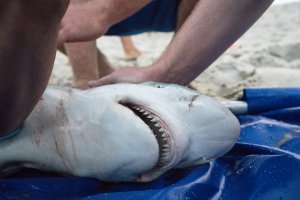 This summer, UCI Scholars will take on research topics ranging from the Jersey Shore’s microscopic plant life to its apex predators.
This summer, UCI Scholars will take on research topics ranging from the Jersey Shore’s microscopic plant life to its apex predators.
The UCI Scholars Program offers competitive grant opportunities to students and faculty of all disciplines whose work would advance core elements of Monmouth’s Strategic Plan and support the UCI’s mission. The latest round of grants will support six projects conducted by 13 students beginning this month. Below are snapshots of the projects.
Chesapeake Bay Archaeological Mapping
Student: Chris Menke
Faculty Mentor: Dr. Geoffrey Fouad, Dept. of History and Anthropology
The project will map probable prehistoric archaeological sites in a coastal reach of Chesapeake Bay by identifying environmental characteristics associated with oyster shell heaps – a sign of past habitation.
Conservation and Demographics of New Jersey Coastal Sharks and Sturgeon
Students: Hannah Craft, Lauren Kelly, Michael Nguyen and Charlie Vasas (Provost Scholar)
Faculty Mentor: Dr. Keith Dunton, Dept. of Biology
Associate Professor Keith Dunton will continue his research into the demographics and habitats of sharks and the endangered Atlantic sturgeon along the New Jersey coast.
Dominican Civil Society: A Democratic Response to Climate Change
Students: Matthew Gruhler and Alexis Vasquez
Faculty Mentor: Dr. Ken Mitchell, Dept. of Political Science and Sociology
The group will examine the question of whether the challenges associated with climate change require the production of social capital (connections among individuals) to solve. They will use the problem of plastic pollution in the Dominican Republic as a proxy for the viability of social capital creation to solve environmental problems.
Harmful Algal Blooms in Monmouth County Coastal Lakes, Estuaries, and Ocean
Students: Skye Post and Ariel Zavala
Faculty Mentor: Dr. Jason Adolf, Dept. of Biology
The researchers will examine the factors contributing to harmful algal blooms, deoxygenation, and fish kills in local waters in order to build a better understanding of their formation and help predict/manage them in the future.
Marine Biology Careers App Design
Students: Gianna Rossi and Stephanie Brown
Faculty Mentor: Prof. Linh Dao, Dept. of Art and Design
The team will collaborate on the design and user interface development of a mobile app dedicated to the exploration of career paths in marine biology for high school students and college freshmen.
Reptile and Amphibian Surveys in Urbanized Ecosystems
Students: Travis Kirk and Christiana Popo
Faculty Mentor: Dr. Sean Sterrett, Dept. of Biology
UCI grant funding will be used to purchase “frog logger” devices which can deployed near breeding sites and programmed to record breeding frog vocalizations. The work is part of a larger project intended to study vertebrate diversity in Monmouth County’s coastal lakes.
Apply Now for Funding
Monmouth University students and faculty are invited to apply now for fall UCI Scholars funding opportunities. Fall grants available include:
- Faculty Enrichment Grants for the enhancement of existing curriculum, new curriculum development, research and scholarship, and team-teaching opportunities. The deadline is June 30.
- Mini-Grants are also available to faculty and students for conference fees, symposia, guest speaker honoraria, equipment and supplies, and other needs to be determined on a case-by-case-basis. Applications can be submitted at any time and are reviewed on a rolling basis. Awards range from $250 to $500 depending on the availability of funds.
Those interested may apply via the UCI Funding Opportunities page on the MyMU Portal (Monmouth University sign-in credentials required). For more information, contact UCI Associate Director Dr. Thomas Herrington at (732) 261-5588 or therring@monmouth.edu.
These opportunities have been made possible through the generous support of Santander Bank and many other corporate and private donors. If you would like to make a tax-deductible gift to the Urban Coast Institute, please use our Give a Gift Now contribution form.
Monmouth Poll: Strong Support for Offshore Wind in New Jersey
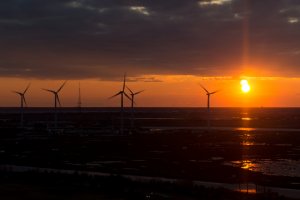 The Monmouth University Poll finds that the vast majority of Garden State residents support the development of electricity-generating wind farms off the state’s coast, which is significantly higher than public backing for oil drilling and expansion of nuclear power. Nearly half say that wind energy development should be a major priority for the state in the coming decade. Support for wind farms decreases, though, if electricity rates were to go up because of a greater investment in wind energy. However, most residents currently expect that their rates will not increase because of wind farm development.
The Monmouth University Poll finds that the vast majority of Garden State residents support the development of electricity-generating wind farms off the state’s coast, which is significantly higher than public backing for oil drilling and expansion of nuclear power. Nearly half say that wind energy development should be a major priority for the state in the coming decade. Support for wind farms decreases, though, if electricity rates were to go up because of a greater investment in wind energy. However, most residents currently expect that their rates will not increase because of wind farm development.
Three-quarters of New Jersey residents (76%) would favor placing electricity-generating wind farms off the coast of the state, while just 15% would oppose this action. Past support for offshore wind farms was slightly higher, ranging between 80% and 84% in polls taken between 2008 and 2011. Support is high among Democrats (79%), independents (77%), and Republicans (69%).
“There is broad, bipartisan agreement that moving forward with offshore wind projects should be a priority. If New Jersey achieves Gov. Murphy’s ambitious goal of generating 3,500 MW of electricity from offshore wind by 2030, it will put the state on a path to a green energy future,” said Tony MacDonald, director of the Urban Coast Institute at Monmouth University.
Click here to read a press release with the full poll results.
Monmouth University to Study Water Pollution at Surfing Beaches
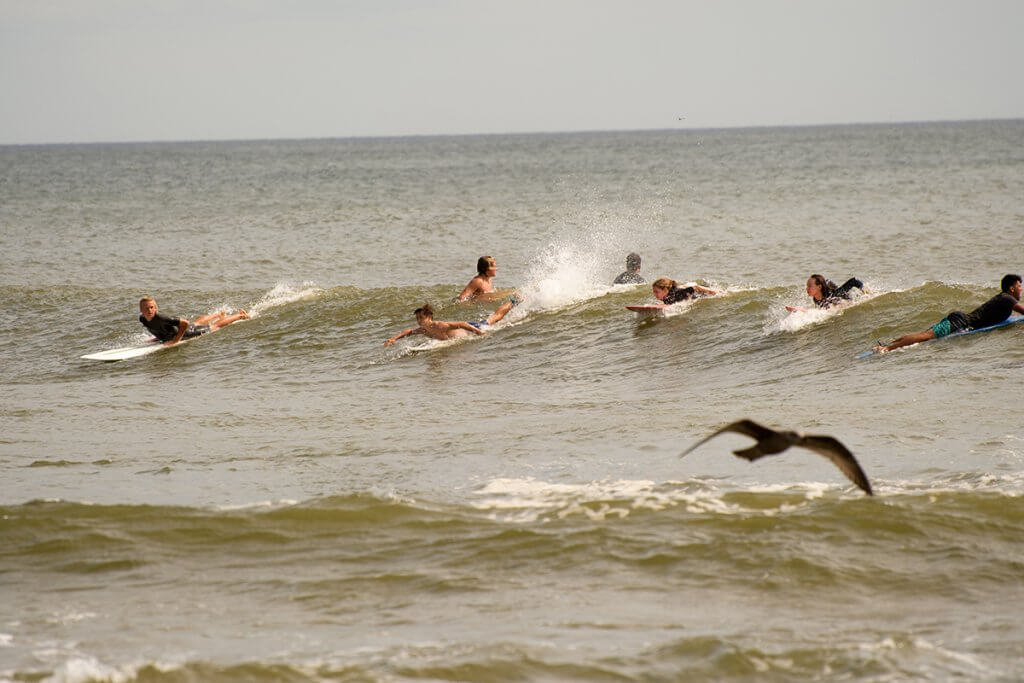
Monmouth University scientists and students have begun a yearlong study on the linkage between rainfall and microbial pollution at surfing beaches in New Jersey including Asbury Park, Deal and Long Branch. The work will be conducted through a $30,000 contract with the Surfers’ Environmental Alliance (SEA).
Microbial pollution, the contamination of water with pathogens that can make people sick, is a problem in densely populated coastal areas around the world. At some of Monmouth County’s most popular surfing beaches, municipal storm drains and outflow pipes discharge directly into the surf zone.
“We’ve heard stories from surfers about how the water sometimes smells and looks different at these beaches after heavy rainstorms,” said Endowed Associate Professor of Marine Science Jason Adolf of Monmouth University’s School of Science and Urban Coast Institute. “However, no data have been gathered to back up the anecdotal evidence about the magnitude of the problem.”
Monmouth University Specialist Professor Jeff Weisburg, the project co-lead, added that there is a significant gap in the state’s sampling program because it is primarily focused on the busiest bathing beaches in the summer tourism season.
“Surfing is a year-round passion at the Jersey Shore, but the state doesn’t test its waters as frequently during some of the best wave months, including the fall hurricane season,” Weisburg said. “This project will help show what kind of health risks, if any, that surfers might be exposed to during the colder months.”
Testing will focus on five locations: the Asbury Park Casino beach in Asbury Park; the Neptune Avenue and Roosevelt Avenue beaches in Deal; and the Ocean Place and S. Bath Avenue beaches in Long Branch.
Each location will be sampled before and after at least 10 storm events over the course of the year. The researchers will record atmospheric conditions and measurements of the ocean’s temperature, dissolved salt levels and clarity before taking water samples near and far from the storm drain pipes at each site. The samples will be analyzed for bacterial abundance and compared with rainfall and water quality data to look for statistical relationships.
“SEA is proud to partner with Monmouth University to implement a long-needed water quality study at local surf spots after rain events,” said the Richard Lee, the organization’s executive director. “We’re hoping this is the start of a long-term collaboration that will benefit the surf community and Monmouth University.”
Professor Soaks Up Superstorm Sandy Data, Reimagines it as Beach Towel Designs
By Hanan Al Asadi, UCI Communications Assistant
Monmouth University Professor Karen Bright has embarked on a creative journey centered on interpreting scientific data related to Superstorm Sandy as abstract artwork. Since early 2017, Bright has been researching statistical information for natural phenomena such as tides, currents, water levels and weather reports and reinterpreting her findings into a uniquely coastal artifact – the beach towel.
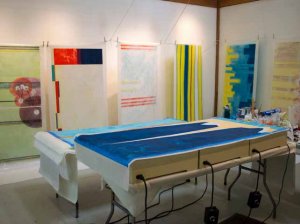 The aim of this project is to study and promote preparedness for future storm events and help the Jersey Shore community view Sandy in a more coherent way. With the support of a UCI grant, Professor Bright, of the University’s Department of Art and Design, has set up a studio with special supplies that include six Roland HOTboxes – heated aluminum plates that artists can use to apply encaustic paint and medium.
The aim of this project is to study and promote preparedness for future storm events and help the Jersey Shore community view Sandy in a more coherent way. With the support of a UCI grant, Professor Bright, of the University’s Department of Art and Design, has set up a studio with special supplies that include six Roland HOTboxes – heated aluminum plates that artists can use to apply encaustic paint and medium.
So far, Bright has collected and analyzed data from sources such as the U.S. Naval Observatory, the National Oceanic and Atmospheric Administration (NOAA), Tides and Currents, and many others. In addition, as an artist in residence at Weir Farm National Historic Site last summer, Bright worked on eight panels related to Sandy with intriguing titles such as “The Shape of Water,” “Four High Tides, Three Counties, 1 Landfall, 1 Full Moon,” and “New Jersey Wind.”
Bright’s initial inspiration occurred as she was introducing a project on information mapping in one of her undergraduate classes. She began thinking about the potential for depicting data in new ways using unconventional material. Bright also mentioned that her motivation occurred as she noticed the media giving attention and covering current hurricanes happening all over the country and comparing them to past storms, while forgetting about Sandy, a storm that had a devastating impact on New Jersey. Afterward, Bright said she started sketching potential ideas in a book and ultimately developed the beach towel project.
In addition to gathering information that helps the community understand how and why Sandy occurred, another major goal for Bright is to create a community event where members can share their stories and relate to each other. As a way to help the healing and recovery process, Bright is planning to create an installation for Monmouth’s Rechnitz Hall DiMattio Gallery. Opening this September, the installation will include: the beach towel display; a public, participatory wall for Sandy stories; a 15-foot-high sculpture that will focus on lost housing units; and a collaboration with a newly hired Assistant Professor/Communications Amanda Stojanov. Bright’s plan is to create a beach hut-themed structure that will house an interactive display of wave forms and sound by Stojanov. The hut, which will be designed to appear distressed and made of found, repurposed material, will be in production in the DiMattio Gallery this summer.
Ultimately, Bright’s project aims to present the data in a recognizable and impactful way. She plans to continue gathering data and investigating Sandy, and hopes she can extend her research into more locations by mapping and creating new artistic approaches to the visualization of global warming and environmental issues. Below is a sample of Bright’s work to date.



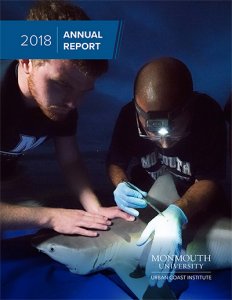 Read the 2018 UCI Annual Report
Read the 2018 UCI Annual Report
The UCI is pleased to present its 2018 Annual Report. The publication looks back at highlights from one of the UCI’s most eventful years to date, including the launch of Monmouth University’s newest and largest research vessel, the Heidi Lynn Sculthorpe; innovative student-faculty research projects; work with the State of New Jersey to begin the development of a comprehensive coastal resilience plan; a partnership to protect Monmouth County coastal lakes; and much more. Visit our report page to browse its pages in a digital flipbook format or download a PDF version.
Story Map: Offshore Wind and the Mid-Atlantic Ocean Data Portal
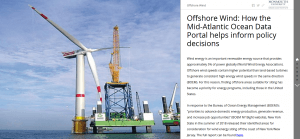 Learn how the Mid-Atlantic Ocean Data Portal is being used to inform discussions on potential locations for offshore wind farms in the New York Bight with a new story map produced by Monmouth University Instructor of GIS Dr. Jennifer Whytlaw.
Learn how the Mid-Atlantic Ocean Data Portal is being used to inform discussions on potential locations for offshore wind farms in the New York Bight with a new story map produced by Monmouth University Instructor of GIS Dr. Jennifer Whytlaw.
The free and publicly accessible Portal (portal.midatlanticocean.org) contains more than 4,000 interactive maps depicting data such as shipping traffic concentrations, marine life distributions, Naval training areas and much more. The story map discusses how the Portal has grown as a resource for government agencies and stakeholder groups to identify complementary and conflicting uses along the coast and in the ocean.
The UCI is a member of the Portal development team, along with the Mid-Atlantic Regional Council on the Ocean, Rutgers University, The Nature Conservancy and Ecotrust. The UCI’s work is supported with a grant from the Gordon and Betty Moore Foundation.
Abate Participates in Moot Court Competitions, Panels on Environmental and Wildlife Issues
Rechnitz Family/UCI Endowed Chair in Marine and Environmental Law and Policy Randall Abate traveled throughout the East Coast this spring engaging students and other stakeholders on issues related to wildlife and environmental protections.
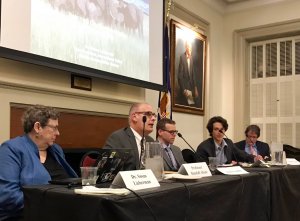 Abate moderated a March 28 panel discussion at the New York City Bar Association titled, “The Endangered Species Act under the Trump Administration.” The panel featured experts on Endangered Species Act regulation and litigation and was jointly sponsored by the Animal Law Committee and the Environmental Law Committee of the New York City Bar Association.
Abate moderated a March 28 panel discussion at the New York City Bar Association titled, “The Endangered Species Act under the Trump Administration.” The panel featured experts on Endangered Species Act regulation and litigation and was jointly sponsored by the Animal Law Committee and the Environmental Law Committee of the New York City Bar Association.
He also recently served as a judge for the two largest moot court competitions in the world on environmental law issues. On Feb. 23, he judged the semifinal rounds of the Jeffrey G. Miller National Environmental Moot Court Competition at Pace University School of Law in White Plains, NY. The competition featured teams from 56 law schools throughout the U.S. The problem for this year’s competition addressed climate justice litigation issues involving the Alien Tort Statute, the public trust doctrine, and the Due Process Clause.
On April 13, Abate judged teams from India, the Philippines and Ireland in the quarterfinal and semifinal rounds of the International Finals of the 23rd Annual International Environmental Moot Court Competition at Stetson University College of Law in Gulfport, FL. The International Finals featured the top two teams from regional competitions in the U.S., Canada, the U.K., Ireland, Australia, New Zealand, East Asia, Southeast Asia, South America, Africa, and Eastern Europe. The problem for this year’s competition addressed how several international environmental law treaties should apply to the use of the Sargasso Sea and the protection of eels.
Finally, Abate was a panelist at Food and Our Changing Climate: A Conference Integrating Science and Law, an interdisciplinary symposium held at the University of Connecticut School of Law on April 26. He delivered a presentation titled “Ocean Iron Fertilization and Indigenous Peoples’ Right to Food: Leveraging International and Domestic Law Protections to Promote Access to Salmon in the Pacific Northwest” to an audience of approximately 150 law professors, law students, scientists, policy experts, and activists. His panel featured legal, policy and economic experts on food supply and security issues in the climate change era.
